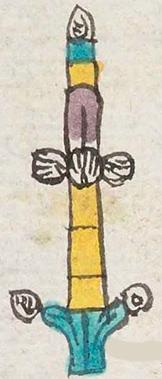Piaztlan (Mdz15v)
This simplex glyph for a tube (piaztli) stands for the place name Piaztlan. The tube has multiple elements that identify it as a tube. It appears to be a segmented, yellow tube, probably from something like cane/reed (acatl)] or bamboo (otlatl)], which does not enter into the phonetic value of the place. Water, with its usual turquoise color, lines of current, and shell and droplet identifiers, appears at both ends of the tube, which helps the viewer realize that the cane is probably hollow and a likely conduit for water. One last interesting detail is that the cane is decorated with white and gray or brown feathers, much like the acatl) sign of the calendar and the arrow (mitl).
Stephanie Wood
Frances Karttunen and others have noted that the tube was typically made from a gourd, whereas it appears much like an acatl in this image, even to the point of having the same decorations as the reed arrow (mitl).
Stephanie Wood
piaztlan. puo
Piaztlan (or Piyaztlan), pueblo
Stephanie Wood
c. 1541, or by 1553 at the latest
Stephanie Wood
reeds, tules, carrizos, plants, arrows, darts, flechas, dardas, Piyaztlan, feathers, plumas, nombres de lugares

piaz(tli), long, thin gourd used to conduct liquid, https://nahuatl.wired-humanities.org/content/piyaztli
-tlan (locative suffix), https://nahuatl.wired-humanities.org/content/tlan
"Piyāztli Place" [Frances Karttunen, unpublished manuscript, used here with her permission.]
"Where There Are Many Sucking Tubes" or "Where There Are Many Long Gourds" (Berdan and Anawalt, 1992, vol. 1, 199)
Codex Mendoza, folio 15 verso, https://digital.bodleian.ox.ac.uk/objects/2fea788e-2aa2-4f08-b6d9-648c00..., image 41 of 188.
The Bodleian Libraries, University of Oxford, hold the original manuscript, the MS. Arch. Selden. A. 1. This image is published here under the UK Creative Commons, “Attribution-NonCommercial-ShareAlike 3.0 License” (CC-BY-NC-SA 3.0).

